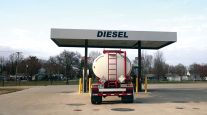Diesel Dips, But Stays Above $4 for 26th Week This Year
This story appears in the Dec. 10 print edition of Transport Topics.
U.S. retail diesel prices inched down 0.7 cent a gallon last week, but at $4.027 the average price of trucking’s main fuel has now topped $4 for a record 26th week this year, the Department of Energy reported.
Diesel has fallen in six of the past seven weeks, DOE said after its Dec. 3 survey of fueling stations; two weeks ago it increased 5.8 cents. Despite the recent declines, diesel is still 9.6 cents above a year earlier.
Before this year, the previous record for the numbers of weeks diesel has topped $4 was 23 weeks in 2008, according to DOE data.
The agency also reported that the gasoline average fell 4.3 cents to $3.394 a gallon. Prior to an 0.8-cent increase the week before, gasoline had fallen 42.1 cents over six weeks. A year ago, gasoline was at $3.29.
Stable crude oil prices, which have fluctuated little in six months, helped hold diesel steady last week, said Sean Hill, oil analyst with DOE’s Energy Information Administration.
“Crude prices, gasoline prices, diesel prices have all been relatively flat, and I say relatively because we’d seen a lot of big drops or big spikes in the previous months,” Hill said.
Crude closed on the New York Mercantile Exchange at $86.26 a barrel on Dec. 6, its lowest level in three weeks.
Terry Drinnen, senior manager for maintenance and equipment at GST Transport Systems, Houston, a fleet of 350 auto haulers, said his company pursues several strategies to save on fuel, including on-site tanks that allow it to meet 60% to 70% of its fuel needs.
Drinnen said GST also governs its truck engines at 65 mph and negotiates fuel agreements with truck stops on regular routes.
“The more you can buy at a truck stop, the more price breaks you’ll get,” Drinnen said.
“The aerodynamic part of the world we’re not really into because we haul automobiles,” Drinnen added. “But we have an ongoing fuel bonus program for our drivers, and we try to buy fuel-efficient equipment that gives us long service life.”
Drinnen recently attended American Trucking Associations’ Summit on Natural Gas in Trucking. He told Transport Topics he heard a lot at the summit about the uncertainty of future fuel prices.
“I think it’s risk,” Drinnen said of the future. “How do you mitigate risk, by either converting to natural gas or mitigating risk in your overall environment?”
He also said he came away from the summit with the thought that GST has lots of issues to explore before it decides whether to convert to natural gas.
The biggest single issue, he said, is the low-slung design of tractors that haul autos.
“It’s not going to let me have as much access to tank sizes that maybe a dry box hauler can have,” Drinnen said.
Looking ahead, EIA’s Hill and Tom Kloza, chief analyst for Oil Price Information Service in Wall, N.J., said the greatest upward pressure on diesel will come from historically low supplies of distillate.
“We’re still so far below typical years that it’s scary,” Kloza said.
Distillate inventories rose 3.03 million barrels late last month, EIA said in a Dec. 5 report. However, stockpiles still totaled only 115.1 million barrels, compared with 141 million a year ago and 160.2 two years ago, EIA said.
Kloza said the low inventories could have sent diesel higher last week were it not for two “speed bumps” slowing down demand: unseasonably warm weather and investor worries about the potential “fiscal cliff” at the end of the year (see story, p. 1).




